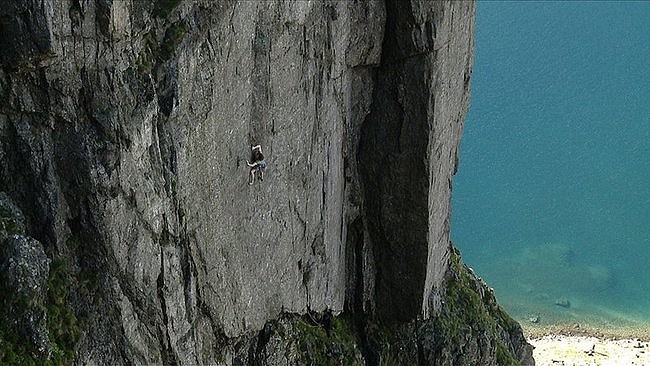Video - Neil Dickson on Margins of the Mind with John Redhead
This video is no longer available. Visit the Posing Productions site for more information about the film 'On-Sight'.

Who on Earth is Neil Dickson?
Neil Dickson is twenty two years old and was born and raised in Conwy, North Wales. He is a committed trad climber and has an impressive tick list of hard and bold on sight ascents. Last year Neil came to prominence with an audacious ascent of his E9 on Lundy; Quetzalcoatl. He climbed the line after minimum inspection on abseil - chopping the bolts and brushing the holds.
He has a no-nonsense attitude to climbing, and is inspired by bold and adventurous lines. He has climbed extensively with James McHaffie, who has clearly been an inspiration. Dickson is tipped by many to take British trad climbing to 'the next level'.
What happened on Margins of the Mind?
Neil made an extremely impressive onsight attempt. The route was dirty and difficult to follow, the climbing was hard and extremely serious. Four hours in to his ascent, Neil found himself high on the route, having passed the crux and facing one tricky move to reach easy ground. His protection was very poor, a tiny RP and a pencil-tip flake:
"I was reversing down back to the gear and a rest. My feeling was that I could lower off this gear but I would not trust a long fall on to it. I needed to be certain that I could climb the last few moves in complete control so I was going up and down to try and work out the moves and clean the holds off a bit before committing to them. I finally worked out a sequence but had lingered on the small holds at my highpoint a little too long, I tried to reverse back to the small wire but my foot shot off a lichenous smear and the small spike punctured two of my finger tips. I slumped onto the gear hooked over the spike and thankfully it held."
As Neil moved around on the rope the spike broke and luckily Neil managed to transfer his weight on to the RP. You can see him pulling the spike off with his hand at the end of this video.
Neil stresses that he wasn't climbing completely out of control:
"You can't just be cavalier about this kind of route"
His steady approach and high level of experience meant that he knew he couldn't just 'go for it' at the top of the route. Hence his climbing up and down until he was certain of what to do.

Exclusive UKC Interview:
Jack: You attempted Margins of the Mind partnered up with John Redhead - and you seem to be drawn to Redhead's routes or those climbed in the Redhead style - without pre-practice - any thoughts about that? Do you draw a parallel between yourself and JR?
Neil: John's routes all follow really inspirational, aesthetic lines. During the eighties when he put up most of his new routes he was in many ways ahead of his time. His approach to climbing was to abseil down new routes to generally see if he thought the line was feasible; check out the gear, look at the holds and a few of the moves. He'd then try the lines from the ground. Whilst he wasn't climbing 'on sight' or completely without inspection, his approach left an amazing legacy of routes that are very onsight-able. People have commented that some of his routes like The Bells, The Bells or indeed even Margins... follow contrived lines. I just don't see this. When you drop a rope down a blank wall and head-point a route, often the most logical thing to do is top rope up in a straight line, ignoring easier possibilities. To me these are the contrived lines. Climbers like John would follow the easiest and most natural lines to climb from the ground and the result is a route that feels like the logical way to go when you're climbing it, not looking at it from a distance. Many of the harder routes that have been established since Redhead's era have relied on extensive pre-practise and so to me many of John's routes still represent the upper boundaries of traditional climbing.
Jack: How do you feel about the grading of routes that have terminal consequences when compared to routes that have large, but comparatively safe falls? For example - Gravediggers/Masters Edge and The Hollow Man/The Bells The Bells.
Neil: A route like Gravediggers is pretty much 100% safe [Editors note, the crux headwall of Gravediggers is protected by a dubious wire in a loose flake, if this wire rips then a ground-fall/ground-sweeping fall is guaranteed]. Comparing its overall difficulty to a route like The Hollow Man, which is very serious, is hard to do. The way I see it is that they are graded for the 'on sight' by the average climber. To give them the same grade would assume that the average climber who could onsight F7c in a scary but safe situation (Gravediggers) would be comfortable onsight soloing a F7a+ whilst trailing a rope which gives them the occasional option to lower off from body-weight gear placements (Hollow Man).
For me these propositions feel approximately equivalent, but I wouldn't really say that I represent the average climber. This is why if someone asked me which was the hardest, I would say that The Hollow Man is overall the hardest route. The more times these routes get repeated, the more their grades are likely to reflect the difficulty that they will present to the 'average climber'. This is an age-old debate, comparing a route like Cenotaph Corner (a very well protected E1 5c) with something like California Arête (an E1 4c solo) is equally difficult but the difference here is that these routes have had many ascents, enabling a consensus to be reached.
Jack: What other routes are you thinking about attempting this year or in the future?
Neil: I'm off to Austria for the summer in a couple of weeks to work on my PhD, so won't be climbing in the UK for a while, but I have a road trip around the UK planned in September which I'm really looking forward to. There are still quite a few big routes that really inspire me in North Wales, I'll attempt them when I feel as if I'm going well. Things like Strawberries, The Quarryman, Face Mecca and... The Indian Face - No, only joking Jack - don't worry I won't be asking for a belay on that one any time soon!
Jack: Whew! Although, we have already come up with a plan to break your leg in the pub the night before you want to try it! Anyway - are you scared on these hard routes that you do? What is your philosophy on risk and danger when climbing?
Neil: I have seen climbers literally go to pieces thorough fear and fall off routes that I know they would walk on a top-rope. I think that controlling your fear is very important when climbing serious routes because being scared starts to affect your ability to climb and can make a potentially already dangerous situation even worse.
If you consider all of the accidents that happen in climbing, then I think very few of them are caused by climbers pushing themselves on dangerous routes. In actual fact when you know that a route is supposed to be serious, given the right approach, the danger can be minimised. To me things that we do casually without giving much thought to are more likely to result in an accident.
Jack: Who in British climbing inspires you the most? And why?
Neil: My friends that I go out climbing with, they inspire me the most.




Comments